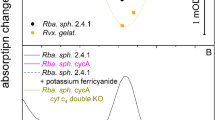Abstract
Photosystem II particles were exposed to 800 W m−2 white light at 20 °C under anoxic conditions. The Fo level of fluorescence was considerably enhanced indicating formation of stable-reduced forms of the primary quinone electron acceptor, QA. The Fm level of fluorescence declined only a little. The g=1.9 and g=1.82 EPR forms characteristic of the bicarbonate-bound and bicarbonate-depleted semiquinone-iron complex, QA −Fe2+, respectively, exhibited differential sensitivity against photoinhibition. The large g=1.9 signal was rapidly diminished but the small g=1.82 signal decreased more slowly. The S2-state multiline signal, the oxygen evolution and photooxidation of the high potential form of cytochrome b-559 were inhibited approximately with the same kinetics as the g=1.9 signal. The low potential form of oxidized cytochrome b-559 and Signal IIslow arising from TyrD + decreased considerably slower than the g=1.9 semiquinone-iron signal. The high potential form of oxidized cytochrome b-559 was diminished faster than the low potential form. Photoinhibition of the g=1.9 and g=1.82 forms of QA was accompanied with the appearance and gradual saturation of the spin-polarized triplet signal of P 680. The amplitude of the radical signal from photoreducible pheophytin remained constant during the 3 hour illumination period. In the thermoluminescence glow curves of particles the Q band (S2QA − charge recombination) was almost completely abolished. To the contrary, the C band (TyrD +QA − charge recombination) increased a little upon illumination. The EPR and thermoluminescence observations suggest that the Photosystem II reaction centers can be classified into two groups with different susceptibility against photoinhibition.
Similar content being viewed by others
Abbreviations
- C band:
-
thermoluminescence band associated with Tyr-D+Q a − charge recombination
- Chl:
-
chlorophyll
- DCMU:
-
3-(3,4-dichlorophenyl)-1,1-dimethylurea
- EPR:
-
electron paramagnetic resonance
- Fo :
-
initial fluorescence
- Fm :
-
maximum fluorescence
- Q band:
-
thermoluminescence band originating from S2Q a -charge recombination
- Q a :
-
the primary quinone electron acceptor of PS II
- P 680:
-
the primary electron donor chlorophyll of PS II
- S2 :
-
oxidation state of the water-splitting system
- Phe:
-
pheophytin
- TL:
-
thermoluminescence
- Tyr d :
-
redox active tyrosine-160 of the D2 protein
References
Blubaugh DJ, Atamian M, Babcock GT, Golbeck JH and Cheniae GM (1991) Photoinhibition of hydroxylamin-extracted Photosystem II membranes: Identification of the sites of photodamage. Biochemistry 30: 7586–7597
Callahan FE, Becker DW and Cheniae GM (1986) Studies on the photoactivation of the water-oxidizing enzyme. II. Characterization of weak light photoinhibition of PS II and its light-induced recovery. Plant Physiol 82: 261–269
Cleland RE, Melis A and Neale P (1986) Mechanism of photoinhibition: Photochemical reaction center inactivation in system II of chloroplasts. Photosynth Res 9: 79–88
Demeter S and Vass I (1984) Charge accumulation and recombination in Photosystem II studied by thermoluminescence. I. Participation of the primary acceptor Q and the secondary acceptor B in the generation of thermoluminescence in chloroplasts. Biochim Biophys Acta 764: 24–32
Demeter S, Goussias Ch, Bernát G, Kovács L and Petrouleas V (1993) Participation of the g=1.9 and g=1.82 EPR forms of the semiquinone-iron complex, QA −Fe2+ of Photosystem II in the generation of the Q and C thermoluminescence bands, respectively. FEBS Lett 336: 352–356
Demeter S, Janda T, Kovács L, Mende D and Wiessner W (1995) Effects of in vivo CO2-depletion on electron transport and photoinhibition in the green algae, Chlamydobotrys stellata and Chlamydomonas reinhardtii. Biochim Biophys Acta 1229: 166–174
Demeter S, Vass I, Horváth G and Laufer A (1984) Charge accumulation and recombination in Photosystem II studied by thermoluminescence. II. Oscillation of the C band induced by flash excitation. Biochim Biophys Acta 764: 33–39
Johnson GN, Boussac A and Rutherford AW (1994) The origin of 40–50°C thermoluminescence bands in Photosystem II. Biochim Biophys Acta 1184: 85–92
Kirilovsky D, Rutherford AW and Etienne AL (1994) Influence of DCMU and ferricyanide on photodamage in Photosystem II. Biochemistry 33: 3087–3095
Setlik I, Allakhverdiev SI, Nedbal L, Setlikova E and Klimov VV (1990) Three types of Photosystem II photoinactivation. 1. Damaging processes on the acceptor side. Photosynth Res 23: 39–48
Styring S, Virgin I, Ehrenberg A and Andersson B (1990) Strong light photoinhibition of electrontransport in Photosystem II. Impairment of the function of the first quinone acceptor, QA. Biochim Biophys Acta 1015: 269–278
vanMieghem FJE, Nitschke W, Mathis P and Rutherford AW (1989) The influence of the quinone-iron electron acceptor complex on the reaction centre photochemistry of Photosystem II. Biochim Biophys Acta 977: 207–214
Vass I and Styring S (1992) Spectroscopic characterization of triplet forming states in Photosystem II. Biochemistry 31: 5957–5963
Vass I and Styring S (1993) Characterization of chlorophyll triplet promoting states in Photosystem II sequentially induced during photoinhibition. Biochemistry 32: 3334–3341
Vass I, Styring S, Hundal T, Koivuniemi A, Aro E-M and Andersson B (1992) Reversible and irreversible intermediates during photoinhibition of Photosystem II: Stable reduced QA species promote chlorophyll triplet formation. Proc Natl Acad Sci USA 89: 1408–1412
Vermaas WFJ and Rutherford AW (1984) EPR measurements on the effects of bicarbonate and triazine resistance on the acceptor side of Photosystem II. FEBS Lett 175: 243–248
Völker M, Ono T, Inoue Y and Renger G (1985) Effect of trypsin on PS II particles, correlation between Hill-activity, Mn-absorbance and peptide pattern. Biochim Biophys Acta 806: 25–34
Author information
Authors and Affiliations
Rights and permissions
About this article
Cite this article
Demeter, S., Nugent, J.H.A., Kovács, L. et al. Comparative EPR and thermoluminescence study of anoxic photoinhibition in Photosystem II particles. Photosynth Res 46, 213–218 (1995). https://doi.org/10.1007/BF00020433
Received:
Accepted:
Issue Date:
DOI: https://doi.org/10.1007/BF00020433




